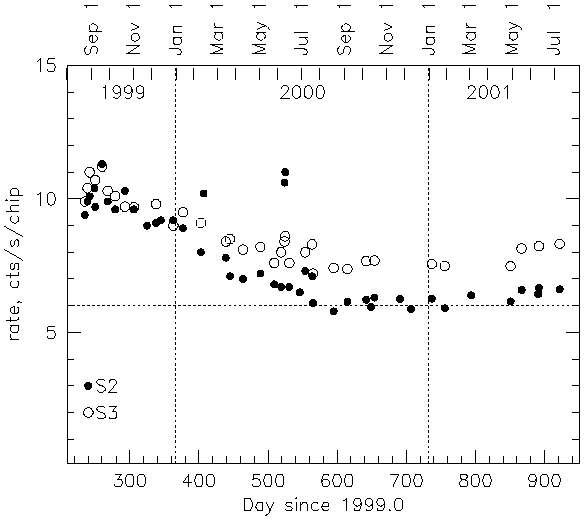 (PS)
(PS)
 (PS)
(PS)
Observations with and without HETG have similar rates, so no distinction is made in the plot. The figure shows that quiescent rates in S2 and S3 have been steadily decreasing from about 10-11 cts/s/chip in August-September 1999 to about 6-8 cts/s/chip at present. The decrease seems to have bottomed out in the Fall of 2000.
Note that if one uses 6 chips and Very Faint mode, the rate 10-11 cts/s/chip is close to saturating the telemetry (leaving almost no room for the target flux or background flares), but if the rate stays where it is now, the probability of saturation in the VF mode during the quiescent times is small.
-------------------------------------------- OBSID date day S2 S3 HETG (cts/s/chip) -------------------------------------------- 1090 1999-08-23 235 9.4 9.9 - 162 1999-08-27 239 9.9 10.4 - 578 1999-08-30 242 10.1 11.0 - 50 1999-09-06 249 10.4 0 - 1249 1999-09-06 250 9.7 10.7 - 1252 1999-09-17 260 11.3 11.2 + 1318 1999-09-25 268 9.9 10.3 + 124 1999-10-06 279 9.6 10.1 - 337 1999-10-20 293 10.3 9.7 + 1458 1999-11-02 306 9.6 9.6 - 966 1999-11-21 325 9.0 0 - 125 1999-12-04 338 9.1 9.8 - 550 1999-12-11 345 9.2 0 - 839 1999-12-29 363 9.2 9.0 - 605 2000-01-12 012 8.9 9.5 + 766 2000-02-07 038 8.0 9.1 - 602 2000-02-11 042 10.2 0 - 420 2000-03-14 074 7.8 8.4 - 387 2000-03-20 080 7.1 8.5 - 610 2000-04-08 099 7.0 8.1 + 1708 2000-05-03 124 7.2 8.2 - 1719 2000-05-23 144 6.8 7.6 + 363 2000-06-02 154 6.7 8.0 - 937 2000-06-07 159 10.6 8.4 - 505 2000-06-08 160 11.0 8.6 - 670 2000-06-14 166 6.7 7.6 - 535 2000-06-29 181 6.5 0 - 399 2000-07-07 189 7.3 8.0 - 241 2000-07-17 199 7.1 8.3 + 5 2000-07-18 200 6.1 7.2 + 943a 2000-08-17 230 5.8 7.4 - 431 2000-09-06 250 6.1 7.4 - 2319 2000-10-15 289 6.3 7.7 - 1671 2000-11-21 326 6.3 0 - 2252 2001-01-06 006 6.3 7.6 - 2266 2001-01-25 025 5.9 7.5 - 2421 2001-03-04 063 6.4 0 - 1699 2001-04-30 120 6.4 7.5 - 1697 2001-05-16 136 6.6 8.1 - 2237 2001-06-09 160 6.4 0 - 2238 2001-06-09 160 6.5 0 - 2241 2001-06-10 161 6.7 8.2 - 1694 2001-07-10 191 6.6 8.3 - --------------------------------------------
Deviations from the trend: a high S2 rate in February 2000 (obsid 602) is during a flare seen in S3 but not in S2 (where the rate of the good events is unusually high by a big factor, but constant, so it doesn't look like a usual background flare). High rate points in June 2000 (obsids 937, 505) correspond to observations without any visible flares, in their usual sense, in either the FI or BI chips -- in obsid 937, the clean event rate in S2 (and other FI chips) is rather constant but too high by a factor of 2, whereas the S3 rate is normal. In obsid 505, there is a bright cluster in the FOV whose contribution is hard to separate.